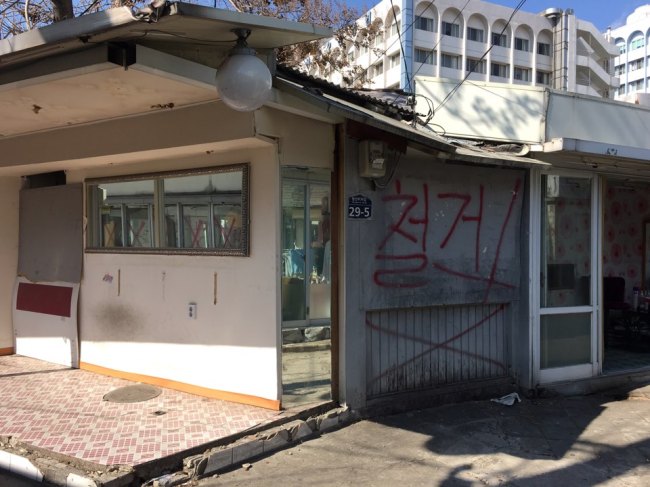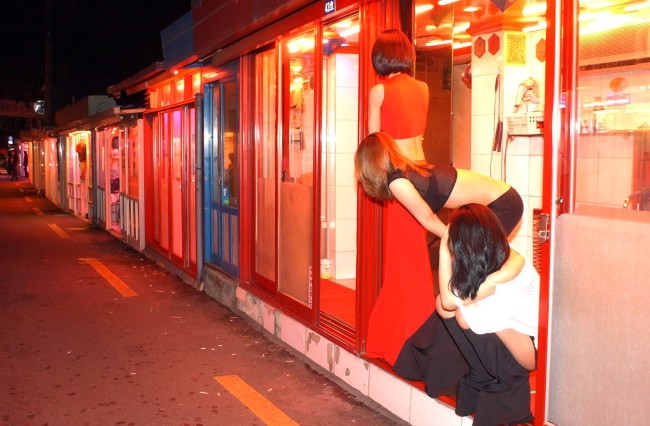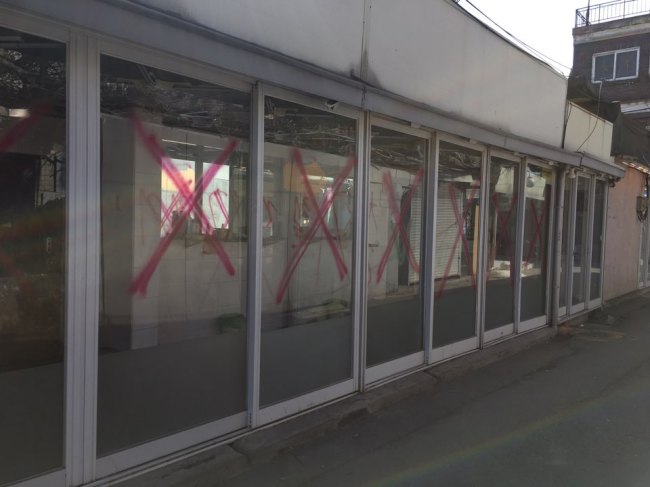Korea's infamous red-light zone to fade into history
Seoul’s once-thriving red-light district readies for redevelopment, but conflicts linger over eviction
By Kim Da-solPublished : March 15, 2017 - 18:13
Cheongnyangni 588, a once thriving red-light district in northeastern Seoul, is counting its remaining days.
Following the district office’s redevelopment plan, announced in December, the removal of brothels resumed earlier this month. By 2020, four 65-story luxury residential-commercial complexes and a 42-story shopping mall are to be erected in the 41,586 square meters area, just five minutes’ walk from Cheongnyangni Station.
Following the district office’s redevelopment plan, announced in December, the removal of brothels resumed earlier this month. By 2020, four 65-story luxury residential-commercial complexes and a 42-story shopping mall are to be erected in the 41,586 square meters area, just five minutes’ walk from Cheongnyangni Station.

Most sex workers and pimps have already left. Most of the 156 brothels are closed, and now the abandoned houses are left with shattered windows and large red letters spelling out “demolition” written on broken walls.
Still, eight shops were in business, refusing to move out, when The Korea Herald visited the area last week.
Although only one or two women were sitting in front of the large window doors to attract customers, a stream of middle-aged men approached them. Only few went inside.
According to the Dongdaemun District Office, 85 percent of 716 households in the area, including regular shops and residential houses near the red-light street, have completed moving out.
The rest are still in negotiation for compensation, the district office said.
Cheongnyangni 588 has long been a major cause of complaints for residents and businesses in the neighboring residential and commercial areas, as Cheongnyangni Station develops into a major shopping center.
“There is much room for growth because Cheongnyangni Station has served as one of the transportation hubs for Seoul by connecting major bus, railway and subway lines,” a real estate agent near Cheongnyangni Station told The Korea Herald.
The redevelopment committee, representing about 130 property owners and tenants, ruled out the possibility of negotiation, saying they have already gone through real estate appraisals for compensation of the land.
Developers already started the demolition process in the neighborhood earlier this month, after receiving a court order that allowed them to demolish and evict the defiant tenants and sex workers.
Some developers even installed surveillance cameras in the neighborhood to drive the sex business out of the area. Sex trade is illegal in South Korea, with sex workers, their clients and pimps all subject to punishment.
A long-time resident and now evictee, surnamed Kim, told The Korea Herald that not enough financial compensation was offered to cover relocation costs.

“The district office and the development committee only agreed to provide 1 million to 1.5 million won ($870-$1,300) for tenants. But you know, we are paying at least 3 million won per month for rent,” said Kim, who is also a member of the association for the evicted or relocated residents.
Yoo Deok-yeol, head of the Dongdaemun District Office, said that there will be “no forced removal“ of tenants and sex workers before the redevelopment construction takes place.
Cheongnyangni 588 enjoyed its heyday in the 1980s and ‘90s, hosting over 1,000 sex workers. It was one of the three largest red-light districts in Seoul, along with one in Cheonho-dong in eastern Seoul and Miari in northern Seoul.
There are two major theories about where the number 588 came from. Some say it came from the street number of the district, Jeonnong-dong 588, while others point to the number of a bus that passes by the district.
But in 2004, an anti-prostitution law made these red-light districts illegal. Since then, the sex business has become more discreet and moved online, reducing demand for brothels like those at Cheongnyangni.
According to statistics last year, there are officially 44 red-light districts in Korea. But the numbers are rapidly falling now.

In 2010, a brothel area around Yongsan Station in central Seoul was removed for a redevelopment project led by Samsung. Another at Miari in northern Seoul has turned residential. Ones in Cheonho-dong in southeastern Seoul and Yeongdeungpo in southwestern Seoul are rapidly losing customers.
Industry workers say the demolition of red-light districts cannot completely root out sex business.
“Many sex workers have already left Cheongnyangni 588, but no one really knows where the evicted sex workers have gone,” said an industry insider who wished to remain anonymous.
“I heard some went to red-light districts in other parts of the country. Others probably went to find jobs at room salons, karaoke bars and massage parlors that receive reservations only online,” she added.
By Kim Da-sol (ddd@heraldcorp.com)









![[Hello India] Hyundai Motor vows to boost 'clean mobility' in India](http://res.heraldm.com/phpwas/restmb_idxmake.php?idx=644&simg=/content/image/2024/04/25/20240425050672_0.jpg&u=)









